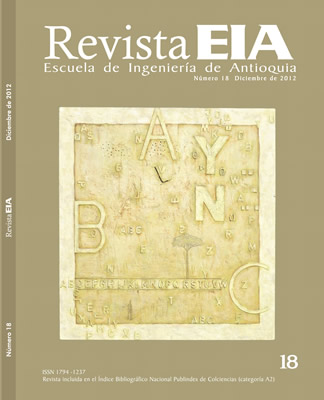DIELECTRIC PROPERTIES OF POLY(VINYL ALCOHOL) HYDROGELS PREPARED BY FREEZING/THAWING TECHNIQUE (PROPIEDADES DIELÉCTRICAS DE HIDROGELES DE ALCOHOL POLIVINÍLICO OBTENIDOS POR LA TÉCNICA DE CONGELAMIENTO/ DESCONGELAMIENTO)
DIELECTRIC PROPERTIES OF POLY(VINYL ALCOHOL) HYDROGELS PREPARED BY FREEZING/THAWING TECHNIQUE (PROPIEDADES DIELÉCTRICAS DE HIDROGELES DE ALCOHOL POLIVINÍLICO OBTENIDOS POR LA TÉCNICA DE CONGELAMIENTO/ DESCONGELAMIENTO)


This work is licensed under a Creative Commons Attribution-NonCommercial-NoDerivatives 4.0 International License.
Copyright statement
The authors exclusively assign to the Universidad EIA, with the power to assign to third parties, all the exploitation rights that derive from the works that are accepted for publication in the Revista EIA, as well as in any product derived from it and, in in particular, those of reproduction, distribution, public communication (including interactive making available) and transformation (including adaptation, modification and, where appropriate, translation), for all types of exploitation (by way of example and not limitation : in paper, electronic, online, computer or audiovisual format, as well as in any other format, even for promotional or advertising purposes and / or for the production of derivative products), for a worldwide territorial scope and for the entire duration of the rights provided for in the current published text of the Intellectual Property Law. This assignment will be made by the authors without the right to any type of remuneration or compensation.
Consequently, the author may not publish or disseminate the works that are selected for publication in the Revista EIA, neither totally nor partially, nor authorize their publication to third parties, without the prior express authorization, requested and granted in writing, from the Univeridad EIA.
Show authors biography
The dielectric behavior of poly(vinyl alcohol) –PVA– crosslinked hydrogels obtained by the repeated freezing/ thawing (F/T) technique have been investigated by dielectric relaxation spectroscopy (DRS) and differential scanning calorimetry (DSC). The crosslinked polymer is produced by the clustering of chains caused by the association of a polar group of the dissolved polymer followed by polymer crystallization. The dielectric spectra obtained from -50 °C to -10 °C show a broad secondary relaxation process associated to local mobility, ß relaxation, which is related to the terminal polar groups (OH). This process is strongly affected by the freezing/thawing cycles applied. The values of tan d are below 1 indicating the dielectric phenomenon is predominant in all samples. The effect of crosslinking PVA on the dynamics of the secondary relaxation process was further analyzed.
Resumen: Por medio de espectroscopia dieléctrica (DRS) y calorimetría diferencial de barrido (DSC) se investigaron las propiedades dieléctricas de los hidrogeles de alcohol polivinílico –PVA– entrecruzados por ciclos repetidos d la técnica congelamiento/descongelamiento. La asociación de los grupos polares del polímero disuelto seguida de su cristalización produce la reticulación del polímero. La espectroscopia dieléctrica obtenida entre -50 °C y -10 °C demostró la existencia de un proceso de relajación secundario asociado con la movilidad de grupos laterales polares OH de la cadena principal, la relajación b. Los ciclos de congelamiento/descongelamiento afectan fuertemente este proceso. El fenómeno dieléctrico predomina en todas las muestras como lo evidencia el valor menor de 1 de tan d. Además, se analizó el efecto del entrecruzamiento en la dinámica de la relajación secundaria.
Article visits 217 | PDF visits 263
